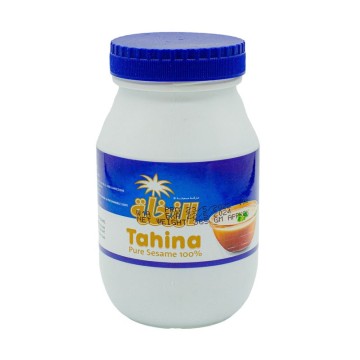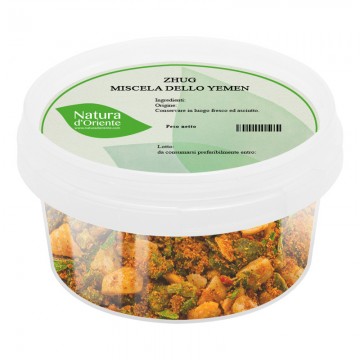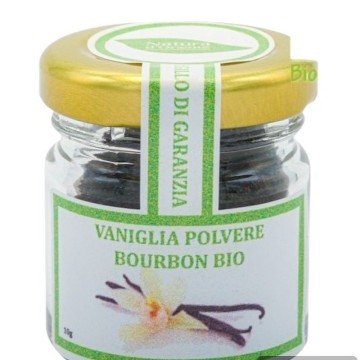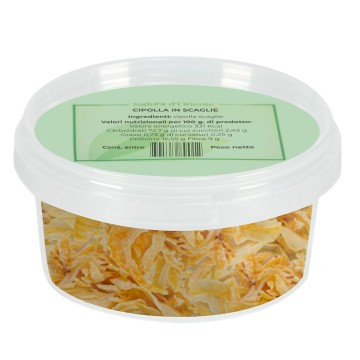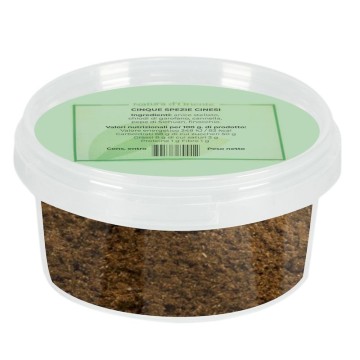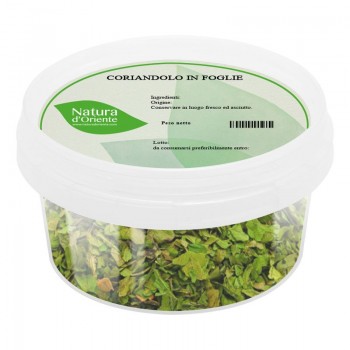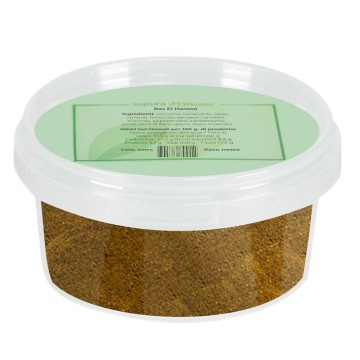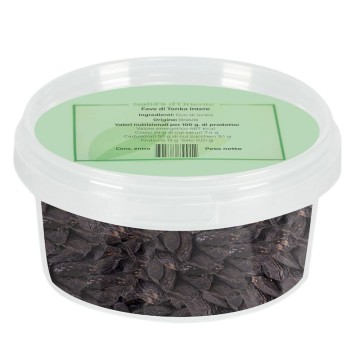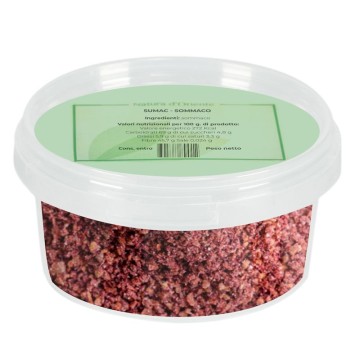Ground thyme is a practical and versatile form of this aromatic herb, known for its flavor and beneficial properties. Appreciated in cooking to make various preparations tastier, it provides a concentrated flavor between pungent and bitter, with a penetrating aroma that evokes citrus fruits, honey, scented hay with some woody notes. Ground thyme offers an intense and concentrated aromatic profile, complex flavors with balsamic and earthy notes. Above all, it promises a perfect consistency to enter the dishes homogeneously.
What are the beneficial properties of thyme?
This aromatic herb provides antioxidant compounds and nutrients, useful for well-being. Thyme contains a good amount of vitamins: A, C, B vitamins, and also makes available various mineral salts such as copper, iron, manganese, potassium, calcium and magnesium. It contains essential oils such as linalool, geraniol and thymol - responsible for its intense aroma and balsamic properties. Due to its content of healthy compounds, thyme is attributed with antioxidant properties, protecting cell membranes against oxidation. What is thyme good for? Known for centuries as a medicinal plant, its leaves contain beneficial substances with balsamic, fluidifying and purifying properties. Thyme is indicated as a natural remedy for some disorders affecting the respiratory tract, given that its essential oil and some compounds (phenols, tannins, flavonoids) are useful from an expectorant, balsamic and purifying point of view. It promotes the fluidity of bronchial secretions, fluidifies and frees the respiratory tract from mucus; useful against coughs and airway congestion. An infusion of thyme therefore facilitates the well-being of the nose and throat, helps relax the muscles and soothes coughs; it has purifying effects against irritation. Thyme is also considered an herb that correctly stimulates digestive function, regular gastrointestinal motility and the elimination of excess gas. It has historically been added to recipes as a spice that simplifies the assimilation of food, also useful as a diuretic. In herbal medicine it is known for external use through infusion, promoting skin well-being. Its aroma is also used to perfume the environment and repel insects, in potpourri.
Where can you buy thyme powder? This aromatic herb is available in a high-quality ground version, in our online spice shop Natura d'Oriente. You can buy loose thyme powder, in packs with variable weights between 50 g, 75 g, 100 g, 150 g, 250 g, 500 g and 1000 g. Our airtight freshness-saving packages ensure excellent preservation in the pantry.
How to use thyme powder?
Very popular in Mediterranean cuisine, thyme is a classic flavoring for Italian and French dishes; it is also part of the Middle Eastern spices, where it adds a spicy and bitter touch, loved in local cuisines. In more recent times it has also found success in Caribbean and American recipes, thanks to its pungent taste.
The scent of thyme (it is an herb of the mint family) introduces a balsamic citrus note that makes it appreciated both in savory dishes and in desserts. A little “secret” to add complexity to your culinary creations.
Ground thyme offers an intense, concentrated aroma and a finely powdered texture to diffuse effortlessly into your dishes, allowing its flavour to blend perfectly with that of your food.
Powdered thyme sprigs are ideal for achieving an evenly distributed, bold and robust flavour. The concentrated nature of ground thyme allows it to infuse the dish with its aromatic strength, with very rich notes. When combined with meats, in particular, it can create a complexity of flavours that tease the palate. In particular in soups, stews, gravies, casseroles and marinades – it introduces a deep, pungent, balsamic and spicy note. For this very reason, powdered thyme should be used sparingly. A little goes a long way to concentrate flavour and fragrance, effectively when used raw. However, it unleashes a powerful effect when heat helps release the essential oils. This concentrated version of thyme, dried and ground, should be dosed in smaller quantities than thyme leaves and fresh thyme. In the latter case the conversion ratio is approximately 1:3 (e.g. 1 tablespoon of fresh thyme leaves corresponds to 1 teaspoon of ground thyme).
In which recipes can thyme be used
Savory recipes: the ground version is useful in many recipes of soups and broths, widespread in Central Europe, flavored with thyme. It is easily used to flavor steamed or boiled vegetables, greens, salads, dishes based on pumpkin, tomatoes, auberginesanes and peppers. Excellent for an intense sprinkling on omelettes and egg-based dishes, it adds flavor to potatoes, pies, soft cheeses, mushrooms. Crushed into a powder, thyme is ideal for fillings with breadcrumbs, vegetables and other herbs; for bread dough, breadsticks and baked goods, which it enlivens with pungent and aromatic notes. It can be added to boiling water for recipes such as boiled potatoes infused with thyme.
First courses: exquisite for sprinkling sauces and condiments for pasta and rice, especially those with tomato, peppers, olives, onions, aubergines and courgettes; it pairs well with all boiled cereals, with a unique aroma in creamy risottos - it intensifies the earthy notes in mushroom risotto.
Meat: thyme has always accompanied meat, as it preserves it by giving it an intense flavor. The powdered version must be dosed carefully, to avoid notes that are too strong and bitter. In the right quantities, ground thyme adds an intense note to delicate meats; perfect on poultry dishes, in lamb stews, on roasts, stews and pan-fried meats. It can add a touch of freshness if used as a light final sprinkling together with other herbs. The ground version is suitable for flavouring the preparation of burgers, meatballs, meat fillings. Thyme can be added to salt water brine to flavour meats such as chicken and turkey.
Fish: a pinch of powdered thyme goes well with all types of fish, shrimp and seafood, spreading its aroma on fish cooked roasted or in a pan; it is used in seafood recipes in a stew, such as pesce all'acqua pazza (stewed cooking). In seafood soups it is best to add it at the end of cooking, to prevent the heat from diminishing the flavour too much - exquisite in creamy thyme and salmon soup.
Sauces: This ground aromatic herb is perfect for marinating grilled or roasted meat and fish; especially mixed in rubs with oil, salt, pepper and spices; or in brandy marinades. It combines easily with butter, oil and vinegar in the preparation of aromatic dressings. It can be used to create sauces, dips with cream or tomato. In thyme spreads, mixing the powder with cheeses, pepper, salt, other herbs and spices. In vinaigrettes, blending the thyme with oil, vinegar and mustard.
Dessert: Dried thyme powder is ideal for cake doughs, biscuits and sweet specialties. In many recipes the citrus and slightly floral notes balance the pungent notes for a remarkable complexity of flavors, which completely transforms the desserts. Thyme offers an interesting contrast in recipes for custards, soft cakes, plum cakes and cupcakes, chocolate desserts, pastries, shortbread and butter cookies. A sprinkling can flavor fresh fruit salads, and create thyme-infused granulated sugar – a staple in some desserts.
Combinations: Thyme is part of the Provençal herb blend, and the Middle Eastern za'atar blend, where it combines with spices like sumac and sesame. In Mediterranean cuisine, it is used in combination with “woody” herbs like rosemary, marjoram, savory, oregano and bay leaves. To tone down its pungent taste, it can be paired with garlic, soy sauce, fish sauce, and lemon.
Drinks: its balsamic scent is useful for flavoring wine, preparing liqueurs and infusions.
The Recipe: Savory biscuits with thyme and lemon
Ingredients for about 40 biscuits 300 g of 00 flour - 60 g of chickpea flour - 10 g of powdered thyme - 1 teaspoon of turmeric - minced garlic to taste - grated zest of 1 lemon - 100 ml of extra virgin olive oil - a pinch of salt - a pinch of pepper - 8 tablespoons of water
Preparation In a bowl, add the powdered ingredients: thyme, garlic, thyme, turmeric, sifted flours. Add the lemon zest, salt, pepper and drizzle the oil to soften. Mix everything together and add the water little by little, until you get a smooth dough. If the dough is too thick, add more water, if it seems liquid, add a spoonful of 00 flour. Knead with your hands and form a loaf, wrap it in cling film. Leave it in the fridge for about 30 minutes. After the necessary time, roll out the dough on a floured surface and use a rolling pin to obtain a thickness of about 1 cm. You can form balls of about 10 g each, giving the biscuits the shape you prefer. Place them on a baking tray lined with baking paper. Preheat the oven to 180°C, then put the tray in the oven and leave to cook for about 10 minutes or until golden brown. When the biscuits are golden brown, take them out of the oven and let them cool.
Origin and history of thyme
The powdered form is obtained from the dried and then ground leaves of plants of the Thymus genus, belongingbelonging to the Lamiaceae family. The genus contains about 400 species of aromatic perennial herbaceous plants, among which the most famous in Italy and in the kitchen is Thymus vulgaris – also known as erbuccia or sermollo. Among the other subspecies, varieties and subvarieties, there are also lemon thyme (Thymus Citriodorus with a lemon aroma) and thyme erba barona (very pungent, used as food for animals) historically thyme was known in the Mediterranean as a medicinal and seasoning herb. It was used together with savory, rosemary and sage – other aromas that perfume the Mediterranean scrub. In the kitchen thyme was also famous for its digestive and preservative properties; it was considered an anti-putrefaction spice to preserve meat while waiting to be cooked. Through marinating, an ancient technique for preserving food, foods were preserved from bacterial degradation (in the absence of refrigerators). Thanks to the presence of essential oil with a natural purifying action, thyme was an excellent preservative. The ancient Egyptians exploited its properties to embalm the deceased, while the Greeks used it in incense to obtain celestial perfumes. They also obtained a thyme honey, from the Thymus capitatus species present on the Athenian mountains. As a medicinal plant, thyme was famous for its virtues useful for respiratory well-being: it was used in natural medicine at the time to alleviate airway disorders and to naturally purify the throat, bronchi, nose, mouth, etc. – it was considered in ancient times to be “the antibiotic of the poor”. The Greek physician Galen recommended thyme as a remedy for joint pain. For food use, the Etruscans and Romans used it as a flavouring for wines and cheeses, and in a digestive sense. It was also used symbolically as a pledge of love and protection: ladies gave sprigs of thyme to their knight, so that he would be defended in battle. Young girls looking for love would collect the sprigs in the first weeks of the year, placing them under their pillows as a good omen for a wedding. Even today, thyme is used both in cooking and for external use, as an infusion herb for beneficial herbal teas and for rinses that cleanse and purify the skin.

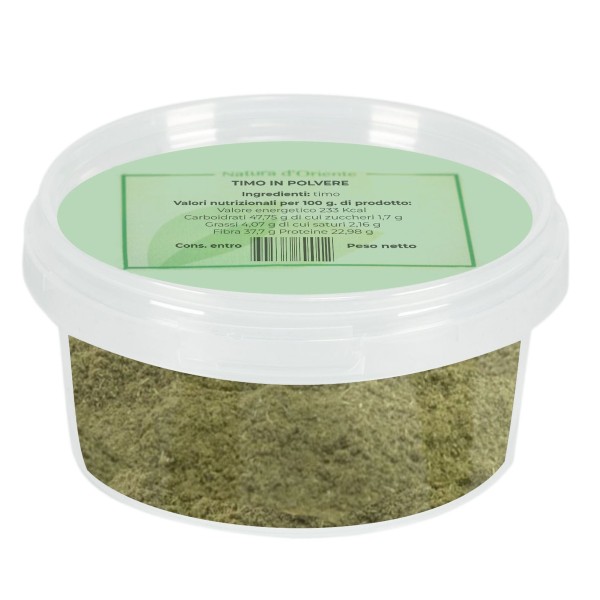







 No reward points for this product.
No reward points for this product.
